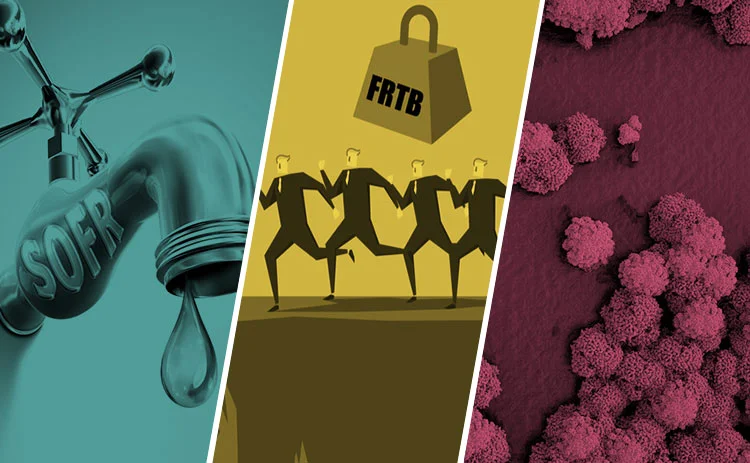
SOFR problems, FRTB and ethical AI
The week on Risk.net, February 2–8, 2019

Banks rocked by U-turn on FRTB equity risk weights
Risk managers warn of higher capital charge after Basel reverts to original 2016 treatment
Quants use AI to cut through murk of ‘sustainability’
Separating the wheat from the chaff is fundamental to ESG investing. Machine learning can do that
SOFR, so bad: liquidity lags transition ambitions
Thin current trading may lead to poor fallback choices, and dim SOFR’s appeal ahead of Libor’s death
COMMENTARY: The mark of virtue
Credit analysis looks easy, in theory. All you’re trying to come up with is an answer to the simple question: how likely is it that this counterparty or this instrument will make the payments expected of it? Wisely, credit rating agencies tend to give their answer in letter form rather than the deceptive precision of a numerical estimate, but there’s no fundamental reason why the answer couldn’t be a percentage (with an appropriate error bar), or why the opinions of different agencies should be very far apart.
The reality, as the world found in 2008, is rather different. To their assessments of the quality of a security, rating agencies often added other considerations like “how annoyed will the issuer be if we don’t give this a triple-A rating” and “how much income do we stand to lose as a result if they take their business elsewhere”. And their credit quality assessments were often woefully wrong and sloppily derived.
Now, the financial industry finds itself facing a far more intractable challenge. Ethical investing – taking environmental, social and governance (ESG) factors into consideration – is booming. And ESG assessment is in high demand.
Unfortunately, ESG analysis makes credit analysis look easy. Asset managers wrestling with the problem point out that different analysts will come up with wildly different rankings of the same underlying; not because of dishonesty, bias or incompetence, but simply because an ESG rating is a highly subjective exercise in condensing a huge array of data into a single result. Is it better to have switched entirely to renewable energy, or to have stamped out gender discrimination in your workforce? Is it worse to hold your corporate retreat four miles down the road from a Chinese concentration camp, or to have helped boost the sales of the addictive opioid drugs that kill over a hundred people a day? (You could always do both, of course.)
Even once these questions have been answered, you still face the problem of handling the volume of data that goes into an ESG assessment – AI software, here as in other areas of investment analysis, is gradually coming into its own as a way to process large amounts of unstructured data from social media chatter to satellite imagery. It will do little to address the subjective aspects of ESG ratings; but it will at least lighten the load on the analyst forced to make the value judgements, and as ESG continues to grow in importance and relevance, that will be a valuable service as well.
STAT OF THE WEEK
A Deutsche Bank-Commerzbank merger would create the tenth largest G-Sib by total leverage exposure, at €1.9 trillion ($2.2 trillion), with the highest G-Sib score of any bank.
QUOTE OF THE WEEK
“If [Metro Bank’s booking error] arose not just from somebody making a stupid mistake, but because systems checks were not properly in place, you can imagine Metro Bank would have a Pillar 2 scalar added until they’ve sorted it out. If you spot something marginal, you might threaten to do it and give them a chance to fix it. But, here, somebody has made a very basic error on the calculations. This is not a matter of opinion or a marginal judgement, where you might classify assets one way or the other” – former senior UK regulator
Further reading
Only users who have a paid subscription or are part of a corporate subscription are able to print or copy content.
To access these options, along with all other subscription benefits, please contact info@risk.net or view our subscription options here: http://subscriptions.risk.net/subscribe
You are currently unable to print this content. Please contact info@risk.net to find out more.
You are currently unable to copy this content. Please contact info@risk.net to find out more.
Copyright Infopro Digital Limited. All rights reserved.
As outlined in our terms and conditions, https://www.infopro-digital.com/terms-and-conditions/subscriptions/ (point 2.4), printing is limited to a single copy.
If you would like to purchase additional rights please email info@risk.net
Copyright Infopro Digital Limited. All rights reserved.
You may share this content using our article tools. As outlined in our terms and conditions, https://www.infopro-digital.com/terms-and-conditions/subscriptions/ (clause 2.4), an Authorised User may only make one copy of the materials for their own personal use. You must also comply with the restrictions in clause 2.5.
If you would like to purchase additional rights please email info@risk.net
More on 7 days in 60 seconds
Bank capital, margining and the return of FX
The week on Risk.net, December 12–18
Hedge fund losses, CLS and a capital floor
The week on Risk.net, December 5–11
Capital buffers, contingent hedges and USD Libor
The week on Risk.net, November 28–December 4
SA-CCR, SOFR lending and model approval
The week on Risk.net, November 21-27, 2020
Fallbacks, Libor and the cultural risks of lockdown
The week on Risk.net, November 14-20, 2020
Climate risk, fixing Libor and tough times for US G-Sibs
The week on Risk.net, November 7-13, 2020
FVA pain, ethical hedging and a degraded copy of Trace
The week on Risk.net, October 31–November 6, 2020
Basis traders, prime brokers and election risk
The week on Risk.net, October 24-30, 2020







